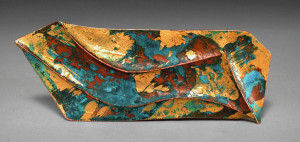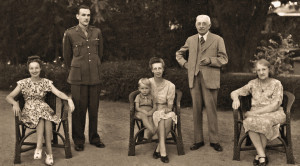Master goldsmith Charles Lewton-Brain, who lives in Calgary, Canada, learned, studied and worked in the art of metalworking in Germany, the USA and Canada. Lewton-Brain is recognized worldwide for his artwork and has now received Canada's highest award for craftsmanship - the Saidye Bronfman Governor Generals Award.
 Patinated brooch in sterling silver, copper, 24-karat gold, nickel-plated sheet metal, silver sheet metal and 24-karat gold sheet metalHewas also one of the founders of the Canadian Chamber of Crafts. In 1996, together with Dr. Hanuman Aspler, he founded the Ganoksin Project, now the world's largest educational website for information about jewelers. This popular website averages 4 million visitors per year and contains more than 1000 pages of Lewton-Brain texts. He is the author of nine books and hundreds of articles and has given hundreds of workshops internationally. Lewton-Brain developed a series of techniques known as "fold-forming" that are considered particularly innovative in metalworking. Lewton-Brain also makes creative use of electroplating in his work. The March 17, 2023 issue of the Canadian magazine "Jewellery Business" features a detailed essay on electroforming entitled "Caged refinement: A deep dive into Charles Lewton-Brain's signature electroforming work": www.jewellerybusiness.com/features/caged-refinement
Patinated brooch in sterling silver, copper, 24-karat gold, nickel-plated sheet metal, silver sheet metal and 24-karat gold sheet metalHewas also one of the founders of the Canadian Chamber of Crafts. In 1996, together with Dr. Hanuman Aspler, he founded the Ganoksin Project, now the world's largest educational website for information about jewelers. This popular website averages 4 million visitors per year and contains more than 1000 pages of Lewton-Brain texts. He is the author of nine books and hundreds of articles and has given hundreds of workshops internationally. Lewton-Brain developed a series of techniques known as "fold-forming" that are considered particularly innovative in metalworking. Lewton-Brain also makes creative use of electroplating in his work. The March 17, 2023 issue of the Canadian magazine "Jewellery Business" features a detailed essay on electroforming entitled "Caged refinement: A deep dive into Charles Lewton-Brain's signature electroforming work": www.jewellerybusiness.com/features/caged-refinement
ABB India expands
Zurich-based ABB, which was formed in 1988 through the merger of Switzerland's BBC and Sweden's Asea, has been present in India since 1949. As a technology company with a focus on automation and electrification, ABB sees good opportunities in the growing Indian market, where sustainability and resource efficiency are now also playing an important role. ABB India, with 27 manufacturing facilities in India, will now significantly increase its capacity and invest in this. Electrification, process automation and robotics are currently among the most important business areas in India. The production capacity of gas-insulated high-voltage switchgear in a factory in Nashik, north-east of Mumbai, has already been doubled. Customers from various sectors such as energy and railroad technology, IT, tunnel and highway construction and many more are supplied from here. The large Indian electroplating industry is also benefiting from the expansion.
Colorful garden city Bengaluru
 Family picture of the Krumbiegels. Second from the right is Gustav Hermann KrumbiegelThesouthern Indian city of Bengaluru is variously described as the IT capital, Silicon Valley of India, start-up capital and garden city. Various personalities have contributed to its reputation as a garden city over the decades and centuries, including Gustav Hermann Krumbiegel. Krumbiegel was born on December 18, 1865 in Lohmen near Dresden and studied horticulture and garden design in Pilnitz. He got a job designing the flowerbeds in Hyde Park, the largest royal park in London. He then became an employee and lecturer at the Royal Botanical Gardens in Kew. Krumbiegel also studied architectural design at Kensington University in his spare time. The Maharaja of Baroda was so impressed by his work that he offered him the position of gardener for the wealthy state of Baroda. Krumbiegel moved to India in 1893 at the age of 26. He died in February 1956 and was buried in the Methodist cemetery on Hosur Road in Bangalore. His epitaph reads: "What he touched, he adorned". The road adjoining the Lalbagh Botanical Garden is still called Krumbiegel Road. However, uncontrolled growth in the last two decades is threatening Bengaluru's status as a garden city.
Family picture of the Krumbiegels. Second from the right is Gustav Hermann KrumbiegelThesouthern Indian city of Bengaluru is variously described as the IT capital, Silicon Valley of India, start-up capital and garden city. Various personalities have contributed to its reputation as a garden city over the decades and centuries, including Gustav Hermann Krumbiegel. Krumbiegel was born on December 18, 1865 in Lohmen near Dresden and studied horticulture and garden design in Pilnitz. He got a job designing the flowerbeds in Hyde Park, the largest royal park in London. He then became an employee and lecturer at the Royal Botanical Gardens in Kew. Krumbiegel also studied architectural design at Kensington University in his spare time. The Maharaja of Baroda was so impressed by his work that he offered him the position of gardener for the wealthy state of Baroda. Krumbiegel moved to India in 1893 at the age of 26. He died in February 1956 and was buried in the Methodist cemetery on Hosur Road in Bangalore. His epitaph reads: "What he touched, he adorned". The road adjoining the Lalbagh Botanical Garden is still called Krumbiegel Road. However, uncontrolled growth in the last two decades is threatening Bengaluru's status as a garden city.


